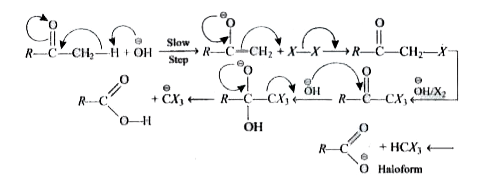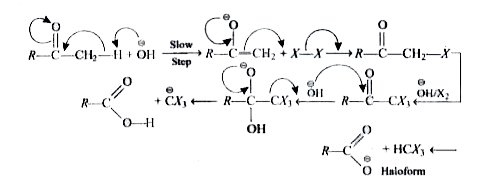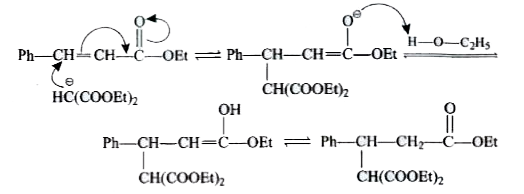Compound Ph−O−O∣∣C−Ph can be prepared by the reaction of _____________.
Phenol and benzoic acid in the presence of NaOH
phenol and benzoyl chloride in the presence of pyridine
phenol and benzoyl chloride in the presence of ZnCl2
phenol and benzaldehyde in the presence of palladium
The correct Answer is:B
To prepare the compound Ph−O−C(=O)−Ph (which is diphenyl ether with a carbonyl group), we need to analyze the given options and determine which reaction will yield the desired product.
1. Identify the Structure: The compound Ph−O−C(=O)−Ph consists of two phenyl groups (Ph) connected by an oxygen atom (O) and a carbonyl group (C=O). This indicates that we are looking for a reaction that introduces both the ether and the carbonyl functionalities.
2. Evaluate Option A:
- Reactants: Phenol and benzoic acid in the presence of sodium hydroxide (NaOH).
- Reaction: Phenol (Ph-OH) is acidic, and benzoic acid is also acidic. When mixed with NaOH, they will form sodium salts (sodium phenoxide and sodium benzoate) but will not yield the desired compound.
- Conclusion: This option will not produce the required compound.
3. Evaluate Option B:
- Reactants: Phenol and benzoyl chloride in the presence of pyridine.
- Reaction:
- Pyridine acts as a base and can deprotonate phenol to form phenoxide ion (Ph-O⁻).
- The phenoxide ion then acts as a nucleophile and attacks the electrophilic carbon of benzoyl chloride (C(=O)-Cl).
- This leads to the formation of the desired compound Ph−O−C(=O)−Ph after the chloride ion (Cl⁻) leaves.
- Conclusion: This option will produce the required compound.
4. Evaluate Option C:
- Reactants: Phenol and benzoyl chloride in the presence of zinc chloride (ZnCl₂).
- Reaction: Zinc chloride is a Lewis acid and does not act as a base to deprotonate phenol. Therefore, it cannot generate the phenoxide ion needed for nucleophilic attack.
- Conclusion: This option will not yield the desired compound.
5. Evaluate Option D:
- Reactants: Phenol and benzaldehyde in the presence of palladium.
- Reaction: Palladium is a metal catalyst often used in coupling reactions, but it does not facilitate the formation of the carbonyl compound from phenol and benzaldehyde.
- Conclusion: This option will not produce the required compound.
Final Conclusion:
The correct answer is Option B: Phenol and benzoyl chloride in the presence of pyridine can be used to prepare the compound Ph−O−C(=O)−Ph.
---
- Reactants: Phenol and benzoic acid in the presence of sodium hydroxide (NaOH).
- Reaction: Phenol (Ph-OH) is acidic, and benzoic acid is also acidic. When mixed with NaOH, they will form sodium salts (sodium phenoxide and sodium benzoate) but will not yield the desired compound.
- Conclusion: This option will not produce the required compound.
- Reactants: Phenol and benzoyl chloride in the presence of pyridine.
- Reaction:
- Pyridine acts as a base and can deprotonate phenol to form phenoxide ion (Ph-O⁻).
- The phenoxide ion then acts as a nucleophile and attacks the electrophilic carbon of benzoyl chloride (C(=O)-Cl).
- This leads to the formation of the desired compound Ph−O−C(=O)−Ph after the chloride ion (Cl⁻) leaves.
- Conclusion: This option will produce the required compound.
- Reactants: Phenol and benzoyl chloride in the presence of zinc chloride (ZnCl₂).
- Reaction: Zinc chloride is a Lewis acid and does not act as a base to deprotonate phenol. Therefore, it cannot generate the phenoxide ion needed for nucleophilic attack.
- Conclusion: This option will not yield the desired compound.
- Reactants: Phenol and benzaldehyde in the presence of palladium.
- Reaction: Palladium is a metal catalyst often used in coupling reactions, but it does not facilitate the formation of the carbonyl compound from phenol and benzaldehyde.
- Conclusion: This option will not produce the required compound.
The correct answer is Option B: Phenol and benzoyl chloride in the presence of pyridine can be used to prepare the compound Ph−O−C(=O)−Ph.
Topper's Solved these Questions
- BOOK - NCERT EXEMPLAR ENGLISHCHAPTER - ALDEHYDE, KETONES AND CARBOXYLIC ACIDSEXERCISE - Short Answer Type Questions28videos
ALDEHYDE, KETONES AND CARBOXYLIC ACIDS
- BOOK - NCERT EXEMPLAR ENGLISHCHAPTER - ALDEHYDE, KETONES AND CARBOXYLIC ACIDSEXERCISE - Long Answer Type Questions4videos
ALDEHYDE, KETONES AND CARBOXYLIC ACIDS
- BOOK - NCERT EXEMPLAR ENGLISHCHAPTER - ALCOHOLS, PHENOLS AND ETHERSEXERCISE - All Questions74videos
ALCOHOLS, PHENOLS AND ETHERS
- BOOK - NCERT EXEMPLAR ENGLISHCHAPTER - AMINESEXERCISE - LONG ANSWER3videos
AMINES
Similar Questions
Knowledge Check
- Question 1 - Select One or More
Mixture of Ph−O∣∣C−H and HCHO is treated with NaOH then Cannizzaro reaction involves
Areduction of HCHOBoxidation of HCHOCreduction of PhCHODoxidation of PhCHO - Question 2 - Select One
Compound having −O∣∣C−CH3 group reacts rapidly with halogen in presence of a base to form haloform. The reaction is known as haloform.
R−O∣∣C−CH3X2+ϴOH−−−−→R−O∣∣C−ϴO+CHX3
Mechanism

Consider the following reactions:
Reaction I →Ph−O∣∣C−CH3Cl2,ϴOH−−−−→Ph−O∣∣C−ϴO+CHCl3
Reaction II →Ph−O∣∣C−CD3−Cl2,ϴOH−−−−→Ph−O∣∣C−ϴO+CDCl3
Which of the following is correct comparison of the rate of reaction I and II?ArI>rIIBrI>rIICrI=rIIDCannot be determined - Question 3 - Select One or More
Compound having −O∣∣C−CH3 group reacts rapidly with halogen in presence of a base to form haloform. The reaction is known as haloform.
R−O∣∣C−CH3X2+ϴOH−−−−→R−O∣∣C−ϴO+CHX3
Mechanism


Which of the following is correct comparisonof rate of haloform reaction with various halogens?ArCl2>rBr2>rI2BrI2>rBr2>rCl2CrCl2=rBr2=rI2DrBr2>rCl2>rI2
Ph−O∣∣C−NH2POCl3−−−→(A), Product (A) is
View SolutionCompound having −O∣∣C−CH3 group reacts rapidly with halogen in presence of a base to form haloform. The reaction is known as haloform.
R−O∣∣C−CH3X2+ϴOH−−−−→R−O∣∣C−ϴO+CHX3
Mechanism

Which of the following will yield iodoform on reaction with I2+NaOH?View SolutionPh−CH=CH−O∣∣C−OH
The IUPAC name is :View SolutionCH3−O∣∣C−H and Ph−O∣∣C−H can be differentiated by :
View SolutionThe base catalysed addition of a compound having active methylene group (or relatively acidic hydrogen) to activate alkene is known as Michael addition reaction.
Ph−CH=CH−O∣∣C−OEt+H2C(COOEt)2C2H5ϴONa⊕−−−−−−→
Ph−CH∣CH(COOEt)2−CH2−O∣∣C−OEt
Mechanism


Find out product of following reaction :
 View Solution
View Solution

